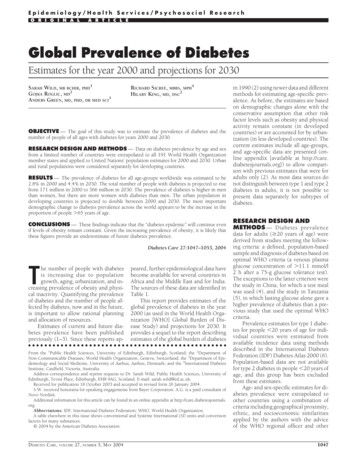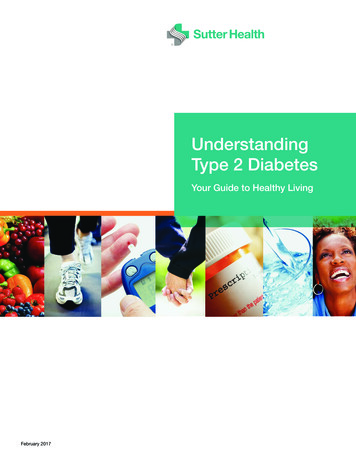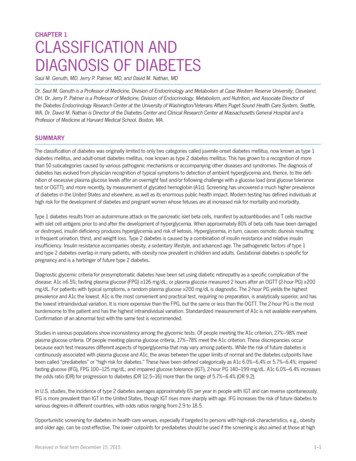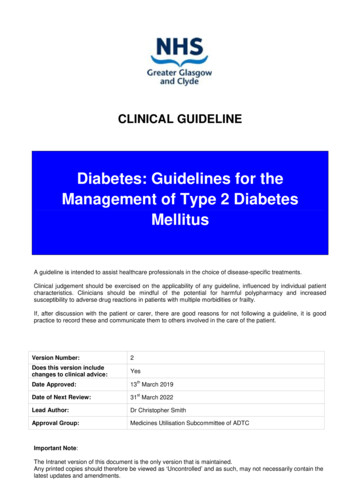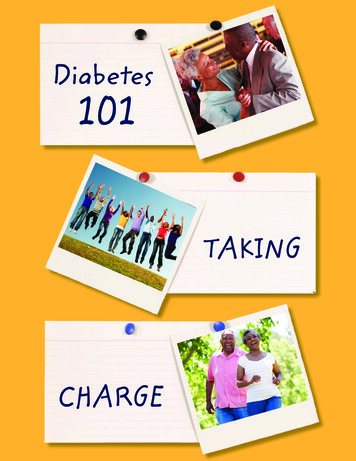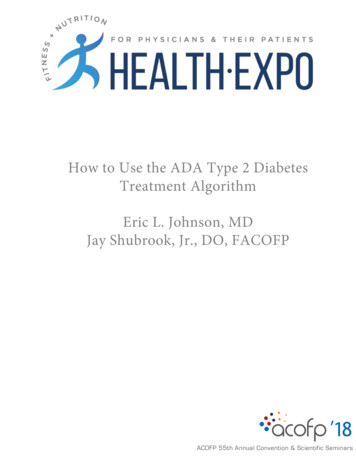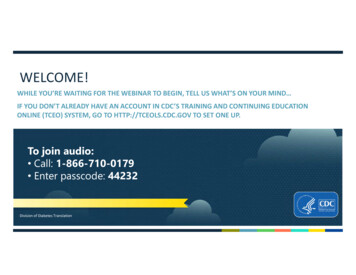
Transcription
WELCOME!WHILE YOU’RE WAITING FOR THE WEBINAR TO BEGIN, TELL US WHAT’S ON YOUR MIND IF YOU DON’T ALREADY HAVE AN ACCOUNT IN CDC’S TRAINING AND CONTINUING EDUCATIONONLINE (TCEO) SYSTEM, GO TO HTTP://TCEOLS.CDC.GOV TO SET ONE UP.To join audio: Call: 1-866-710-0179 Enter passcode: 44232Division of Diabetes Translation
INSERT PAT’S BIO HEREWayne Millington, MPASenior Public Health AdvisorCDC, Division of Diabetes Translation Provides strategic direction on public healthpolicy, program, and practice Develops and implements public healthprograms in collaboration with state and localpublic health organizations Previously served as Response Deputy forCDC’s Emergency Response Center2
ADOBE CHAT BOX If you have a question, please type it inthe Chat Box at any time. We will do our best to respond to chatquestions during the webinar and willfollow up after the event as well.3
EDIT MY INFO TO INCLUDE AFFILIATIONIf you haven’t included your affiliation afteryour name, please do so by selecting, “Edit MyInfo ” from the top-right corner of theAttendees box.4
OBJECTIVES FOR TODAY Recognize challenges men face in preventing type 2 diabetes or livingwith diabetes. Identify barriers for men’s participation and retention in type 2diabetes prevention and management programs. Identify strategies to increase men’s participation in type 2 diabetesprevention program or DSMES (diabetes self-management educationand support) services.5
HEALTH IS A TEAM SPORT: A PLAYBOOK FORENGAGING MEN IN DIABETES PREVENTION ANDMANAGEMENTFeaturing Guest Panelists:Moderated by:Peter SimpsonDr. Salvatore (Sal) GiorgianniAaron PerryDarryl DavidsonWayne Millington, MPASenior Public Health AdvisorCenters for Disease Control and PreventionDivision of Diabetes Translation
7
Peter SimpsonPrincipal and Founderxsperient Over 49 years of global business experience Consultant to the health care industry where heworked on developing psychology-basedmethodologies for medical market research Skills include: strategic planning processes market segmentation health care marketing8
CURRENTLANDSCAPE:MEN ANDDIABETES9
Total: 30.3 million people have diabetes(9.4% of the US population)Diagnosed: 23.1 million peopleUndiagnosed: 7.2 million people(23.8% of people with diabetes are undiagnosed)10Source: Diabetes Report Card 2017 - reportcard2017-508.pdf
11
IS DIABETES A MALE AND ETHNIC ISSUE?Estimated Adult Diabetes–Percentage Less than High School – 12.6% High School – 9.5% More than High School - 7.2%Estimated Adult Diabetes –millions (2015 Women – Diagnosed 11.7 Men – Diagnosed 11.3 Women – Undiagnosed 3.1 Men – Undiagnosed 4.0Total 30.1Prevalence by Demographics– Percentage Native American 15.1%Non-Hispanic Black 12.7%Hispanic 12.1%Asian 8.0%White Caucasian 7.4% (Men higherthan women)12Source: National Diabetes Statistics Report, 2017. CDC
PARTICIPATION IN A NATIONAL DIABETES PREVENTION PROGRAMLIFESTYLE CHANGE PROGRAM BY 81,70175.53Not Reported5450.15Source: Diabetes Prevention Recognition Program Registry, 201913
PREDIABETESIS THEGATEWAY TOTYPE 2DIABETES14
DIABETES, OBESITY, AND FOOD DESERTS LARGELY OVERLAPIt is reasonable to suppose that prediabetes maps out in the same way.15
Source: xsperient ConnexionPoints Prediabetes Study 201816
THE HEALTH CARE SYSTEM IS LARGELY INEFFECTIVE Only 44% of those with prediabetessay that their physician discusses itwith them at every visit 25% say their physician discusses itwith them “rarely”17Source: xsperient ConnexionPoints Prediabetes survey 2018 n 302
DIAGNOSIS DOES NOT DRIVE BETTER BEHAVIOR45%40%35%30%25%20%15%10%5%0%Favor CarbsTry to Avoid CarbsT2DPreDOthersAvoid Carbs18
MEN AND WOMEN ARE DIFFERENT Men are less likely to: receive an annual checkup from their primary (48% vs. 60%) visit for an illness or concern (33% vs. 42%) use a walk-in clinic (13% vs. 18%) Men spend less effort researching their physicians They are more comfortable taking medications (1–7 scale, Top Two Box, 30% vs. 20%) They have a much lower regard for the US health care system (School Scorecard assessment,rating E or F 45% vs. 25%)Source: xsperient US Health care Consumer Survey 2016 n 800 (50:50 male: female. US demographic balance, alldifference significant at the 95% CI)19
MEN AND WOMEN’S PREDIABETES EXPERIENCE IS DIFFERENT Women were more likely to report a diagnosis of obesity (51% vs 34%)and anxiety (45% vs 31%). In the last year, 19% of US adults werediagnosed with anxiety, an estimated 31% on a lifetime basis. Men were are more likely to know their A1C score (64% vs. 48%). Women were more likely to report attendance in National DiabetesPrevention Program lifestyle change programs (LCPs) (75% vs. 25%).Source: National Institutes of Mental Health website accessed s/any-anxiety-disorder.shtml20
“It is more important to knowwhat kind of patient has thedisease than what kind ofdisease the patient has.”– Sir William Osler,1849-191921
22
PERSONASMART PERSONALITY BASED HEALTH CARE ENGAGEMENT MODEL People behave accordingto who they are, not whatconditions they have orissues they face Our Global Health andWellness EngagementScale is personality-driven It has proven itselfeverywhere from acuteillness through wellnessbehaviors to diet andnutritionProactiveFaces up tosituationsShares andcommunicatesMakes theirown decisionsSeeksNormalityWant to behealthy butonly deals withthe wellnesswhen theyhave toHopefulAvoidersHopes thingswill turn outokDepressed,frightenedBut can befatalistic andAvoidanceorientedSkipsappointmentsand treatmentsLives foreach day23Based on xsperient’s accumulated research in Health care, PersonaSmart , OnTheWall
PreContemplationContemplationPreparationThe Transtheoretical Model of Health CareBehavioral Change is used for each of theHealth Care Engagement Types.Primary research is then conducted in thecontext of the target condition.ActionMaintenanceTerminationJames O. Prochaska of the University of RhodeIsland, and Carlo Di Clemente and colleaguesdeveloped the transtheoretical model beginning in1977. It is based on analysis and use of differenttheories of psychotherapy, hence the name"transtheoretical".24
SUMMARY While we know these are stereotypes and may not apply to all, we shouldconsider when engaging with men on health care, that at times men: look after their cars like women look after their bodies (and vice versa) deny conditions and think of obesity and diabetes as “normal” seek convenient solutions Clinics inside stores and pharmacies (one example being a CVS HealthHUB ) Easy parking, in and out quickly25
BARRIERS:MEN ANDDIABETES26
Dr. Sal Giorgianni, BSc, PharmDSenior Science AdvisorMen’s Health Network 27 years of experience at Pfizer Co-founder and Chair-Emeritus of the AmericanPublic Health Association section on men’s health Practices clinical pharmacy at Viera FamilyMedicine and Wellness/Via Health27
MEN’S HEALTH NETWORK Oldest and largest organization thatfocuses on men (founded 1992)Health prevention, screening,education, and advocacy.Mission reach men and their familieswhere they live, work, play, and prayChapters in several stateBoard of advisors and science advisorswww.menshealthnetwork.orgWeb takes in over 400K hits/monthmostly for information28
MEN AND THEIR HEALTH Men and boys acculturated to not think of health as their responsibility Hunter gatherers not caregivers (evolutionary) Workplace image of the “tough” executive where chronic conditions orhealth care visits are signs of a “weak boss” (sociological) Men are acculturated to disregard wellness: “Suck it up and take it like a man!” “Real men don’t eat quiche.” “What a great athlete-he’s playing with a broken !”29
MEDIA AND MALE PERCEPTIONS OF ROLE IN HEALTH Action roles - predominantly men Men who care about health portrayed as un-cool Men and boys do not read about health as oftenor as long as women do Health advertising* in general audience monthlymagazine images and messages targets: 73% women and girls*analysis of commercial health advertising 19% menDr. S. Giorgianni, Presented as a scientific session atAPHA Annual Conference 2011 8% gender neutral30 0% boys
HEALTH CARE SYSTEM IS NOT “MEN-FRIENDLY” Providers are products of their own gender-based acculturationNo comprehensive men’s health doctorsNo annual wellness visits covered for boys or menFew/superficial men’s health curricula in professional programsProcess of exam and care predicated on relinquishing control Few resources and little outreach to men from federal and state agencies No federal office of men’s health Few state offices of men’s health—only two or three funded Disparity in NIH funding for men’s health specific research31
HEALTH CARE SYSTEM IS NOT “MEN-FRIENDLY” Only 61% men vs. 81% of women can identify with a “regular physician”*Fewer men have regular medical visits (76% men vs. 92% women within a year)*Women make twice as many preventive care visits as men*Many so-called “men’s health” centers focus on reproductive health issues as a mainstayMen wait longer to see physician when symptoms occur—often complicating treatmentWomen seek care for diabetes much sooner to time of diagnosis than men do—menusually seek care only when disease has progressed to problematic symptoms.32* CDC Use of Ambulatory Care Services By Women-1998/2004
Stigma of disease is one of the most difficult andubiquitous barriers that needs to be addressed.Stigma is often compounded by socioeconomic andsociocultural factors.33
The Uncomfortable Truth AboutBoys and Men and Health 34
35
36
PREVENTION AND AWARENESS AT EARLY AGE CAN HELP TOCOUNTERBALANCE ANTI-HEALTH ACCULTURATION Use sports physicals Implement a multi-system screening program Carefully approach discussions of prediabetes which may feed intostigma and inadvertently drive men away from self-care Use informational and educational tools DESIGNED FOR BOYS & MENAND THE MOST INFLUENTIAL OF ALL TOOLS?37
Linking treatment of diabetes (or other relevantchronic disease) to the prevention or managementof Erectile Dysfunction is a very effective technique.38
BECOME INVOLVED AT THE COMMUNITY/WORKPLACE ARENA Programs specifically for boys and men (PSAs are a great draw for men) Integrate into places where boys go for fun (i.e. sports, community service groups, orscouting) Bring programs to men where they gather (i.e., the workplace, Rotary or Lions clubs) Use a bit of humor to reach males: this can help to diffuse the “tension” and dislike ofhealth issues (i.e., “Prostate and Pancakes” type programs) Teach women to encourage boys and men to address health care (i.e. no naggingor being dogmatic, just consistent gentle persuasion)39
40
Aaron G. PerryCEO/FounderRebalanced-Life Wellness Association Former police officer World’s 1st African American with type 1 diabetesto complete the Ironman Triathlon 2018 Time magazine’s “The Health Care 50 –Thinking Outside the Hospital” Opened the nation’s first Men’s Health &Education Center located inside the City ofMadison’s largest black barbershop to improve theoverall life expectancy for black males41
Darryl DavidsonMen’s Health ManagerCity of Milwaukee Oversees programs, preventative education, andoutreach activities related to teen males and men Helped establish a Men’s Health Center as theentry point to address various issues that affectmale health Member of the National Men’s Health Networkand founding member of the American PublicHealth Association’s Men’s Health Caucus42
EXAMPLEPROGRAM:MEN ANDDIABETES43
UNDERSTANDING DIABETES Education, income, and where we liveare as important to our health as ourbehavior, health care, and geneticscombined. In Wisconsin, black men's life expectancyis 7 years shorter than white men. African-Americans in Dane County sufferhigher rates of cancer, obesity, anddiabetes as compared to whites.Source: Madison Dane County Public Health and The African44American Wellness Project
BARRIERS When black men have diabetes, theyare more likely to develop seriouscomplications associated with thedisease (1.5 to 2.5 times more likelyto have a limb amputated). Fear, lack of trust, shame, and poorcommunication are barriers.Source: Madison Dane County Public Health and The AfricanAmerican Wellness Project45
46
THE DIABETES PROJECT: MILWAUKEE, WISCONSIN Trained educators in “Healthy Living with Diabetes”curriculum Stanford University-developed high-level evidence-based workshop for people who have diabetes 2-1/2 hours once a week for six weeks (withWisconsin Institute for Healthy Aging and theHousing Authority of the City of Milwaukee)47Source: Madison Dane County Public Health and The African American Wellness Project
THE DIABETES PROJECT: MILWAUKEE, WISCONSIN Sustainable eye disease screening systemusing mobile teleophthalmology Partners: Medical College of Wisconsin, TheUnited Community Center, the City ofMilwaukee Well Woman Program, CarrollUniversity and Marquette University48
THE DIABETES PROJECT: MILWAUKEE, WISCONSIN Performed over 800 screenings and identified early stages of diabetes usingeye screening as an entry point to address preventive health concerns. Men's Health Public Health Nurse and Health Educator trained to screenand educate clients using A1C screening at the Men's Health Centers.49
Health care disparitiesare impacted by socialdeterminants of health: education level, employment, housing, income level, and access to communityresources.Closing gaps requiresmeeting people wherethey are and establishingrelationships.50
Engaging Black Men in Activities - Building Social Cohesion Black males focusing on healthy living. Black males living with chronic health conditions. Black males with a family history of diabetes. Black males with a prediabetes diagnosis. Black males maintaining healthy weight.
QUESTIONS?COMMENTS?EMAIL: DDT DIABETESWEBINAR@CDC.GOV52
CLAIM YOUR CONTINUING EDUCATION CREDIT TODAY This activity has been approved for continuing education. More information can be found here:https://www.cdc.gov/diabetes/ndep/pdfs/NDEP Accreditation Statement.pdf If you don’t have an account in CDC’s Training and Continuing Education Online (TCEO) system, you willneed to start by creating one. Go to https://tceols.cdc.gov/ to set up an account.oOnce you have an account, you can use it for all of your future CDC continuing education activities. In order to receive continuing education (CE) for SC2607-072419 - National Diabetes Education ProgramWebinar Series – Health Is a Team Sport: A Playbook for Engaging Men in Diabetes Prevention andManagement - July 24, 2019 (Webcast), please visit TCEO (https://www.cdc.gov/getCE) and follow these9 Simple Steps (https://tceols.cdc.gov/Home/Steps) before August 19, 2019. If you already have an account, click the link you receive after the webinar to access this webinar in TCEO. Complete the post-test and evaluation. You have 60 days to claim credit for today’s webinar. If you have questions about today’s webinar, please contact DDT DiabetesWebinar@cdc.gov. Thewebinar evaluation is anonymous, and we can’t respond to questions included on the evaluation.Continuing education isavailable for CNE, CHEC,CPH, and IACET.If your profession isn’tlisted, please check withyour accreditingorganization aboutaccepting IACET units orcredit from one of theother organizations listed.53
THANK YOUFor more information please contact the Centers for Disease Control and Prevention1600 Clifton Road NE, Atlanta, GA 30333Telephone: 1-800-CDC-INFO (232-4636)/TTY: 1-888-232-6348Visit: www.cdc.gov Contact CDC at: 1-800-CDC-INFO or www.cdc.gov/infoThe findings and conclusions in this report are those of the authors and do not necessarilyrepresent the official position of the Centers for Disease Control and Prevention.54
No comprehensive men’s health doctors No annual wellness visits covered for boys or men Few/superficial men’s health curricula in professional programs Process of exam and care predicated on relinquishing control Few resources and little outreach to men from federal and state age

